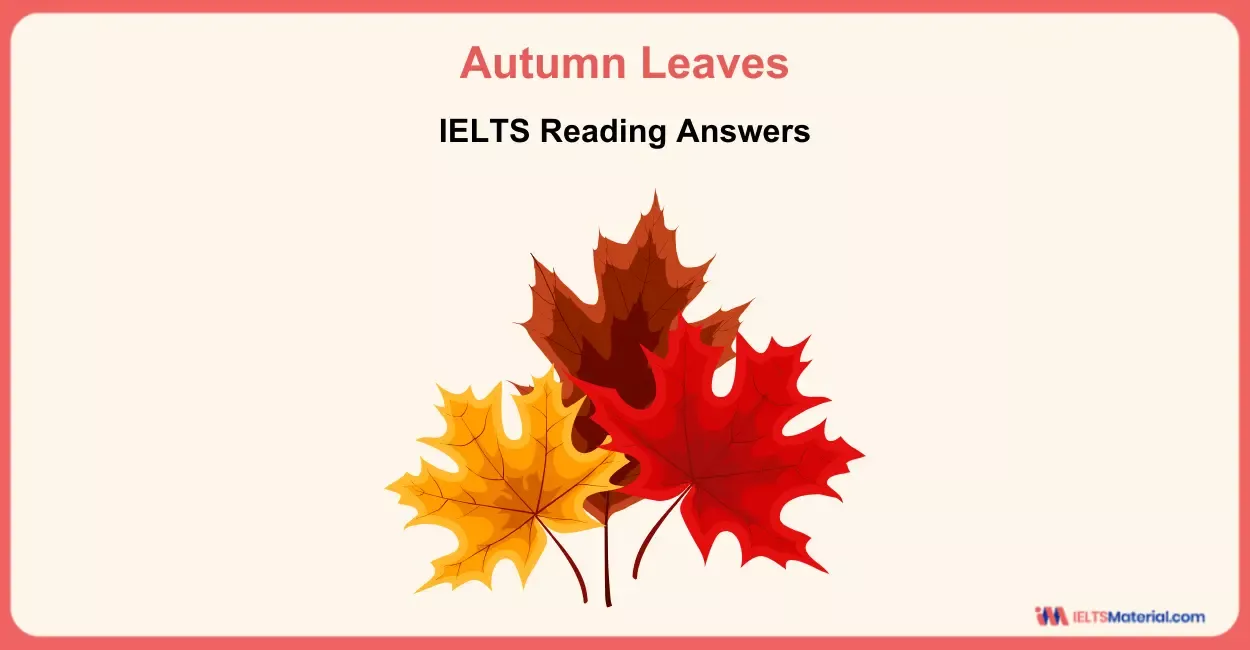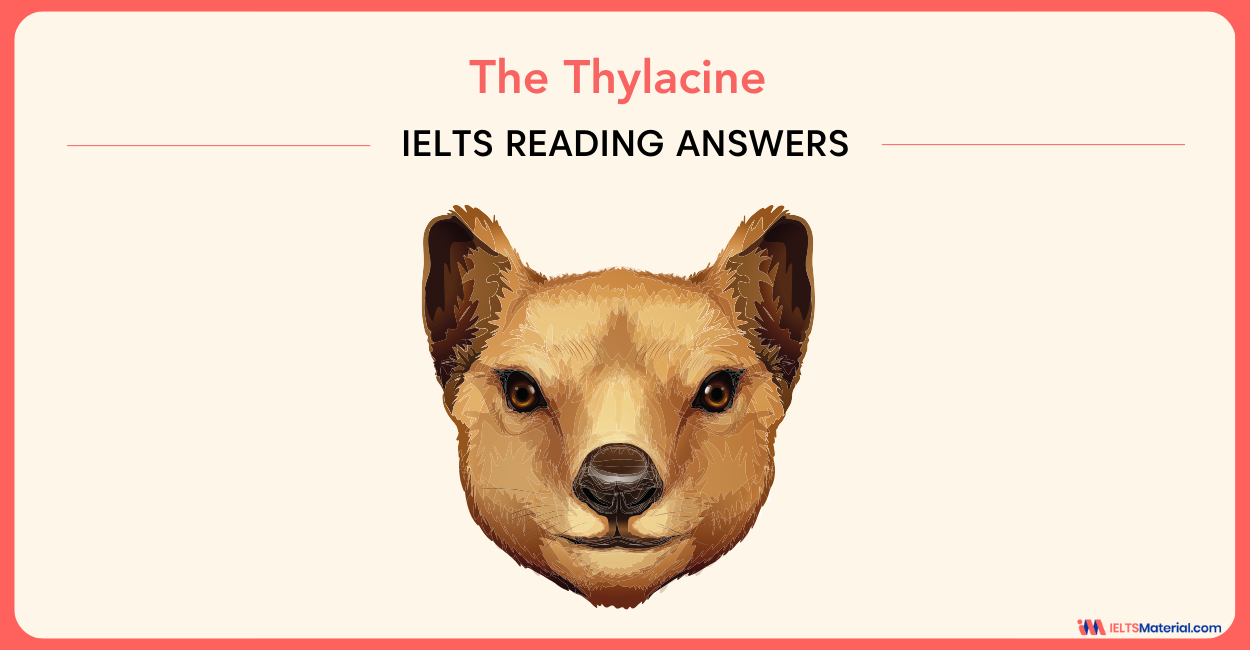The Thylacine – IELTS Reading Answers
10 min read
Updated On
-
Copy link
Unravel the band 8+ tips to attempt key question types like sentence completion and True/False/Not Given with the IELTS Reading passage, ‘The Thylacine’. Boost your reading skills and identifying details while aiming to achieve a higher band score.
Table of Contents

Limited-Time Offer : Access a FREE 10-Day IELTS Study Plan!
‘The Thylacine’ is an academic reading passage which provides you with an opportunity to attempt different question types. You need to improve your skills in scanning, skimming, and deep comprehension so that you can get a higher band score. As you prepare for the IELTS Reading section, you need to utilize strategies so that you can build confidence for the exam day.
As the IELTS Reading passage on ‘The Thylacine’ simulates the actual exam conditions, you need to answer all the questions within 20 minutes. By incorporating specific tips into your preparation, you will be able to find answers easily. Therefore, try to find the answers yourself and then check out the right answers given for this passage.
Connect with our band 9 IELTS Trainers to crack your IELTS Reading in no time! Book a FREE Demo.
Types of Questions in the IELTS Reading Passage ‘The Thylacine’
Remember to not read the passage in the beginning since that would waste your time. It is recommended to always look at the question types which you will encounter. In the passage, ‘The Thylacine’, you would be answering two types of questions for which you need to first understand how to approach them. This will make you feel prepared while developing your skills in finding the right answer.
The question types found in the ‘The Thylacine’ passage are:
- IELTS Reading Sentence Completion (Q. 1-5)
- IELTS Reading True False Not Given (Q. 6-13)
How to Attempt Questions in IELTS Reading Passage ‘The Thylacine’?
To succeed in answering the two types of questions provided in the IELTS Reading Passage, ‘The Thylacine’, it is necessary to use a few IELTS Exam Preparation Tips for Band Score of 8+. Always note the areas of improvement to continuously work on them but with a strategic plan. Below are certain ways which will guide you in your practice sessions as you attempt questions in the IELTS Reading Section.
- Do not start reading the passage directly since you might be wasting your time. Instead, it is suggested that you look at the questions first to understand what type you need to answer and then move on to the passage.
- Skimming and scanning techniques are two very important skills so that you can spot the information easily and understand the overall meaning of the paragraph. As you practice reading, these skills will help you improve your reading speed as well.
- Since the information for all questions are provided chronologically, it is best to move on to the next question if you feel stuck. You can always come back to the question as by then, you will be aware of the area where you might find the answer.
- Always put the timer on since you need to be aware of the Time Management for IELTS Reading. As you focus on each question type, you can take only a minute to answer them.
- For Sentence Completion type of questions, try to understand the meaning of the sentence first. In this way, you would be able to identify the type of word which is missing. With this technique, you will narrow down your options.
- Always check your answer and once you have filled in the gap, make sure that your answer makes sense in the context of the sentence. Therefore, you need to practice the important topics from IELTS Grammar to understand sentence structures.
- To answer True/False/Not Given questions, you need to be able to understand the passage and identify the key information. You also need to be able to distinguish between statements that are explicitly stated, contradicted, and not given.
- Remember that all questions will be paraphrased so you must not answer based on your skills on How to Ace IELTS Reading with 'Keyword Technique'. You need to understand the context in which the keywords have been used after which you must also look for the entire information.
Curious to learn how to answer True, False, and Not Given questions correctly? Check out the video below!
IELTS Reading Passage on The Thylacine
You should spend about 20 minutes on Questions 1-13, which are based on the Reading Passage below.
The Thylacine
The extinct thylacine, also known as the Tasmanian tiger, was a marsupial that bore a superficial resemblance to a dog. Its most distinguishing feature was the 13-19 dark brown stripes over its back, beginning at the rear of the body and extending onto the tail. The thylacine’s average nose- to-tail length for adult males was 162.6 cm, compared to 153.7 cm for females.
The thylacine appeared to occupy most types of terrain except dense rainforest, with open eucalyptus forest thought to be its prime habitat. In terms of feeding, it was exclusively carnivorous, and its stomach was muscular with an ability to distend so that it could eat large amounts of food at one time, probably an adaptation to compensate for long periods when hunting was unsuccessful and food scarce. The thylacine was not a fast runner and probably caught its prey by exhausting it during a long pursuit. During long-distance chases, thylacines were likely to have relied more on scent than any other sense. They emerged to hunt during the evening, night and early morning and tended to retreat to the hills and forest for shelter during the day. Despite the common name ‘tiger’, the thylacine had a shy, nervous temperament. Although mainly nocturnal, it was sighted moving during the day and some individuals were even recorded basking in the sun.
The thylacine had an extended breeding season from winter to spring, with indications that some breeding took place throughout the year. The thylacine, like all marsupials, was tiny and hairless when born. New-borns crawled into the pouch on the belly of their mother, and attached themselves to one of the four teats, remaining there for up to three months. When old enough to leave the pouch, the young stayed in a lair such as a deep rocky cave, well-hidden nest or hollow log, whilst the mother hunted.
Approximately 4,000 years ago, the thylacine was widespread throughout New Guinea and most of mainland Australia, as well as the island of Tasmania. The most recent, well-dated occurrence of a thylacine on the mainland is a carbon-dated fossil from Murray Cave in Western Australia, which is around 3,100 years old. Its extinction coincided closely with the arrival of wild dogs called dingoes in Australia and a similar predator in New Guinea. Dingoes never reached Tasmania, and most scientists see this as the main reason for the thylacine’s survival there.
The dramatic decline of the thylacine in Tasmania, which began in the 1830s and continued for a century, is generally attributed to the relentless efforts of sheep farmers and bounty hunters with shotguns. While this determined campaign undoubtedly played a large part, it is likely that various other factors also contributed to the decline and eventual extinction of the species. These include competition with wild dogs introduced by European settlers, loss of habitat along with the disappearance of prey species, and a distemper-like disease which may also have affected the thylacine.
There was only one successful attempt to breed a thylacine in captivity, at Melbourne Zoo in 1899. This was despite the large numbers that went through some zoos, particularly London Zoo and Tasmania’s Hobart Zoo. The famous naturalist John Gould foresaw the thylacine’s demise when he published his Mammals of Australia between 1848 and 1863, writing, ‘The numbers of this singular animal will speedily diminish, extermination will have its full . way, and it will then, like the wolf of England and Scotland, be recorded as an animal of the past.’
However, there seems to have been little public pressure to preserve the thylacine, nor was much concern expressed by scientists at the decline of this species in the decades that followed. A notable exception was T.T. Flynn, Professor of Biology at the University of Tasmania. In 1914, he was sufficiently concerned about the scarcity of the thylacine to suggest that some should be captured and placed on a small island. But it was not until 1929, with the species on the very edge of extinction, that Tasmania’s Animals and Birds Protection Board passed a motion protecting thylacines only for the month of December, which was thought to be their prime breeding season. The last known wild thylacine to be killed was shot by a farmer in the north-east of Tasmania in 1930, leaving just captive specimens. Official protection of the species by the Tasmanian government was introduced in July 193′, 59 days before the last known individual died in Hobart Zoo on 7th September, 1936.
There have been numerous expeditions and searches for the thylacine over the years, none of which has produced definitive evidence that thylacines still exist. The species was declared extinct by the Tasmanian government in 1986.
Questions 1-5
Complete the notes below.
Choose ONE WORD ONLY from the passage for each answer.
The thylacine
Appearance and behaviour
-
Looked rather like a dog
-
Had a series of stripes along its body and tail
-
Ate an entirely 1 ……………… diet
-
Probably depended mainly on 2 ………………. when hunting
-
Young spent the first months of life inside its mother’s 3 …………………..
Decline and extinction
-
Last evidence in mainland Australia is a 3100-year-old 4 ………………
-
Probably went extinct in mainland Australia due to animals known as dingoes
-
Reduction in 5 ………………. and available sources of food were partly responsible for the decline in Tasmania
Questions 6-13
Do the following statements agree with the information given in the Reading Passage? In boxes 6-13 on your answer sheet, write
TRUE if the statement agrees with the information
FALSE if the statement contradicts the information
NOT GIVEN if there is no information on this
6 Significant numbers of thylacines were killed by humans from the 1830s onwards.
7 Several thylacines were born in zoos during the late 1800s.
8 John Gould’s prediction about thylacine surprised some biologists.
9 In the early 1900s, many scientists became worried about the possible extinction of the thylacine.
10 T. T. Flynn’s proposal to rehome captive thylacines on an island proved to be impractical.
11 There were still reasonable numbers of thylacines in existence when a piece of legislation protecting the species during their breeding season was passed.
12 From 1930 to 1936, the only known living thylacines were all in captivity.
13 Attempts to find living thylacine’ are now rarely made.
Want to improve your IELTS Academic Reading score? Grab the IELTS Reading (Academic) Test Guide: Essential Tips, Strategies, and Practice Tests” (April-June 2025).
Answers With Location and Explanation for IELTS Reading Passage ‘The Thylacine’
Did you attempt the two question types? Were you able to find all the answers? Let’s compare your answer with the correct ones and read further for the explanations and location of the ‘The Thylacine’ IELTS reading answer. Note the areas where you made mistakes in order to avoid it in the future. In this way, you will be able to level up your reading preparation and achieve a higher IELTS Band Score.
|
Answer |
Question type |
Answer Location |
Answer Explanation |
|
1. Carnivorous |
Sentence completion |
Paragraph 2, Line 3 |
The thylacine had an exclusively carnivorous diet. |
|
2. Scent |
Sentence completion |
Paragraph 2, Line 1 |
During long-distance chases, thylacines were likely to have relied more on scent than any other sense. |
|
3. Pouch |
Sentence completion |
Paragraph 3, Line 1 |
New-born thylacines crawled into the pouch on the belly of their mother. |
|
4. Fossil |
Sentence completion |
Paragraph 4, Line 1 |
The most recent, well-dated occurrence of a thylacine on the mainland is a carbon-dated fossil from Murray Cave in Western Australia, around 3,100 years old. |
|
5. Habitat |
Sentence completion |
Paragraph 5, Line 1 |
The decline of the thylacine in Tasmania was attributed to factors like competition with introduced wild dogs, loss of habitat, and disappearing prey species. |
|
6. True |
True/False/Not given |
Paragraph 5, Line 1 |
The passage mentions the decline of the thylacine in Tasmania from the 1830s due to the efforts of sheep farmers and bounty hunters. |
|
7. False |
True/False/Not given |
Paragraph 6, Line 1 |
The passage states that there was only one successful attempt to breed a thylacine in captivity, at Melbourne Zoo in 1899. |
|
8. Not given |
True/False/Not given |
N. A. |
The passage doesn’t provide information about how John Gould’s prediction about the thylacine was received by biologists. |
|
9. False |
True/False/Not given |
Paragraph 7, Line 1 |
The passage mentions that there was little public pressure to preserve the thylacine in the decades following its decline. |
|
10. Not given |
True/False/Not given |
Paragraph N. A. |
The passage doesn’t provide information about the practicality or outcome of T. T. Flynn’s proposal to rehome captive thylacines on an island. |
|
11. False |
True/False/Not given |
Paragraph 7, Line 8 |
The passage mentions that official protection of the thylacine by the Tasmanian government was introduced in July 1936, 59 days before the last known individual died. |
|
12. True |
True/False/Not given |
Paragraph 7, Line 9 |
The passage states that the last known wild thylacine was shot in 1930, leaving only captive specimens from 1930 to 1936. |
|
13. Not given |
True/False/Not given |
N. A. |
The passage doesn’t provide information about the frequency of attempts to find living thylacines. |
Enroll into our Free IELTS Webinar and learn more about techniques to improve your reading speed.
As you prepare yourself for the reading module, check out and practice more IELTS Reading passages like this one on ‘The Thylacine’. With regular practice sessions, you will be able to enhance your skills and learn how to approach different question types. However, always note the areas of improvement to continuously elevate your skills to achieve a band 8+.
Check More Reading Passages
|
The Grapes of Winter, Islands That Float, Ocean Plant Life In Decline Reading Answers |
|
|
The Loch Ness Monster, Co- Educational Versus Single Sex Classrooms – IELTS Reading Answers |
Also Check:
Practice IELTS Reading based on question types

Start Preparing for IELTS: Get Your 10-Day Study Plan Today!
Explore other Reading Practice Tests

Kasturika Samanta

Kasturika Samanta

Nehasri Ravishenbagam
Recent Articles

Nehasri Ravishenbagam

Haniya Yashfeen

Haniya Yashfeen

Haniya Yashfeen





Post your Comments